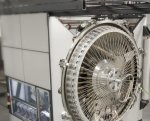Twin Creeks Technologies’ Hyperion system can produce silicon wafers less than one-tenth the thickness of conventional wafers and thinner than a human hair.
While silicon cells of today may be only what seems to be a tiny 200 millionths of a meter thick, much of the material serves to give the wafer structure and only a very thin surface layer converts sunlight to energy. The wasted silicon represents a waste of resources and money as silicon is still the most expensive component of a finished solar panel.
Hyperion employs a technique called Proton Induced Exfoliation (PIE), where hydrogen ions are fired into donor wafers of silicon; forming a uniform layer beneath the surface of the donor without changing the silicon’s properties and characteristics.
This layer, called a lamina, becomes a production wafer that can be used to create ultra-thin solar cells or semiconductor devices. At just 20 microns thick, these layers make a human hair seem incredibly thick by comparison (50 – 120 microns).
“By eliminating excess material, we will help solar manufacturers produce modules that compete with grid power and open up new markets for chip makers,” says Dr. Siva Sivaram, CEO of Twin Creeks.
Twin Creeks Technologies states a solar cell manufacturing plant based on Hyperion can produce cells for less than 40 cents a watt, or nearly half of the price of current conventional systems. A single system can process over 1.5 million thin wafers per year – the equivalent of more than 6 megawatts of solar cells.
While the company is focusing on silicon wafers for now, Hyperion can be used to produce thin wafers made from gallium arsenide, germanium and other materials.
Twin Creeks has constructed a commercial demonstration plant in Senatobia, Mississippi currently capable of producing 25 megawatts of solar cells a year. As the Hyperion process is further refined, the facility will be expanded to 100 megawatts annual production capacity.
Headquartered in Silicon Valley, California, Twin Creek Technologies has a portfolio of over 60 patent applications.







































